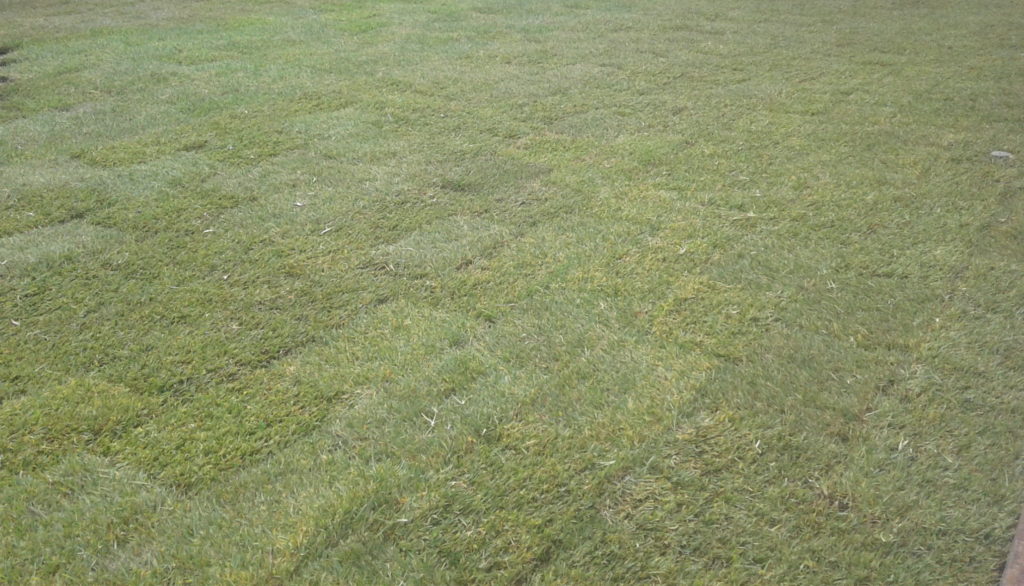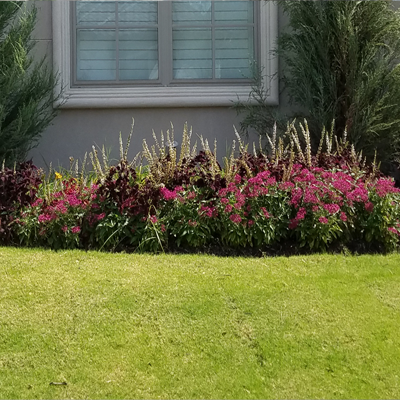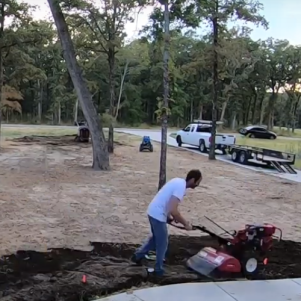SOD GRASS TYPES INSTALLED
St. Augustine
St. Augustine grass is a widely used grass for lawns along the golf coast. This grass is a very old grass type that has been mentioned in many old records from Uruguay, Brazi, Nigeria, Sierra Leone, Bermuda and South Carolina. It is know to be found around coastal regions and the edge of freshwater or saltwater marshlands. St. Augustine grass is well suited for full sun, full shade and anything in-between, making it an excellent grass for lawns. This is the most common lawn grass for any yards in Louisiana. Getting St. Augustine sod for your yard is always a good idea, being a great choice for almost any situation your Louisiana yard could throw at it. Out of the 200 or so years that St Augustine has been propagated from the plant not by seed, only a few strains or varieties have evolved and none have been developed through grass breeding programs. The most common strain was a fertile diploid with a white stigma color and is native to the Golf-Caribbean – W. African region. At some point this species may have crossed with another Stenographer to come up with the sterile triplod strain originally reported in S. Africa. This strain is distinguished from the common strain by its purple stigma colorm and has been found in Australia, New Zealand and in the Pacific Islands. It has been planted in Florida and California since at least 1920. One of the few grasses of St. Augustine that was chosen from the common strain called Texas Common is a Dwarf type called Garretts 141. This strain was patented for its seed production but with its lack of cold tolerance it does not have a chance any higher than south Florida or south Texas. Another strain was released by the North Carolina Experiment Station in 1980 as a cold tolerant strain, was Raleigh St. Augustine. Raleigh is very shade tolerant for the strain but is not resistant to cinch bugs. The strain that is most common oldest noted and most used is called Texas Common a strain of St. Augustine grass grown and produced commercially in Texas since about 1920. Texas Common is a typical description from old records of the white stigma type reported to be native to the Gulf-Caribbean-West African region. Texas Common was found to be a fertile diploid with 18 chromosomes. Seedling progeny from this white stigma type show wide variations in morphological characters. Since this strain has been propagated from its vegetate form for over 100 years, only a few variations in the grass have been produced. Natural variants of the common strain are found throughout the state and region. It is assumed that these variants developed from seed produced by the common strains of St. Augustine grass.
Bermuda
Bermuda sod is a grass originating from Africa, not Bermuda. It is an abundant invasive species in Bermuda and it is presumed to have entered North America from Bermuda giving it the common name we know it as today. Hundreds of cultivars have been created for specific requirements. The most common Bermuda sod is the Tifway 419. This grass was made to combine very durable grass with beauty. This grass is used everywhere grass can be used. For example residential yards, commercial yards, fairways, roughs, soccer fields, football fields and other applications. Bermuda Tifway 419 was developed by a geneticist at the University Of Georga named Dr. Glenn Burton, at the Georgia Coastal Plain Experiment Station in Tifton 1960. Since then the 419 strain is one of the most common choices for residential and commercial lawns, as well as golf course fairways nation wide. The extreme disease resistance, and drought tolerant make this grass an excellent sod choice. When you add a high level of traffic resistance you can pretty much use this grass for any type of sport field with great success.
Zoysia
The Zoysia sod grass is a creeping grass native to China, Japan and other parts of Southeast Asia. The first introduction of Zoysia in the United States was in 1911. The grass is named after the Slovenain botanist Karl von Zois (1756-1799). This grass can tolerate a wide range of sunlight and water as well as being very disease resistant. Less fertilization is required and Zoysia is less vulnerable to fungus and insect damage. Zoysia is used widely for residential lawns and fairways at golf courses. It holds up well to traffic and is an excellent fine textured grass. Great at holding soil together on slopes for erosion control, Zoysia can form dense mats the grow over low features. The most popular cultivar of this grass is called Zoysia ‘Emerald’. Low maintenance requirements make this grass a must have for your yard.
Centipede
Centipede grass is native to Southern China and in brought to the United Stated in 1916. This grass is very common now in southeastern states and Hawaii. When healthy this Full sun and slightly shade tolerant grass is very aggressive and is capable of choking out most weeds. Centipede grass is a coarse textured, low maintenance grass. With medium shade tolerance and limited traffic tolerance, it is a very easy lawn to take care of. This grass spreads by stolons, and is a light green color. With shoots that come out of the sod that look similar to a Centipede, that is how it got its name. It does not require much fertilization, in fact with too much nitrogen it will be less tolerant to a freeze. With light freeze the grass will not die but this grass is a warm season grass.
Our Content
Ground Leveling & Soil Amendments
Locations
Chateau Estates
Kenner
Metairie
River Ridge
Harahan
Social Media
2019 DLC SERVICE – (504) 338-2206
Privacy Policy – Terms & Conditions – Sitemap
WEBSITE DESIGN by Changing SEO





